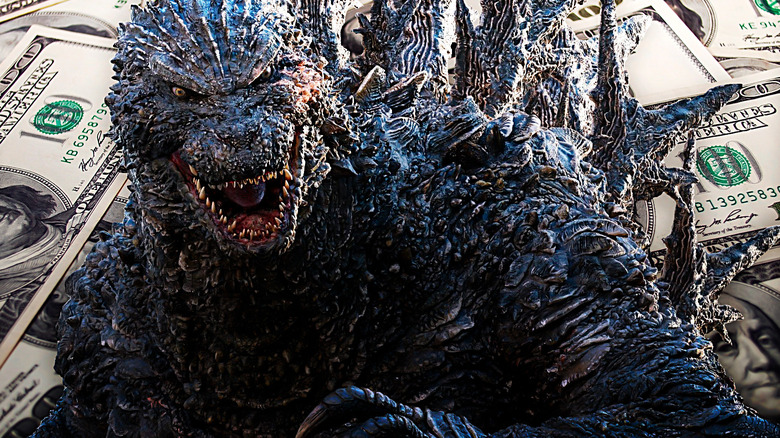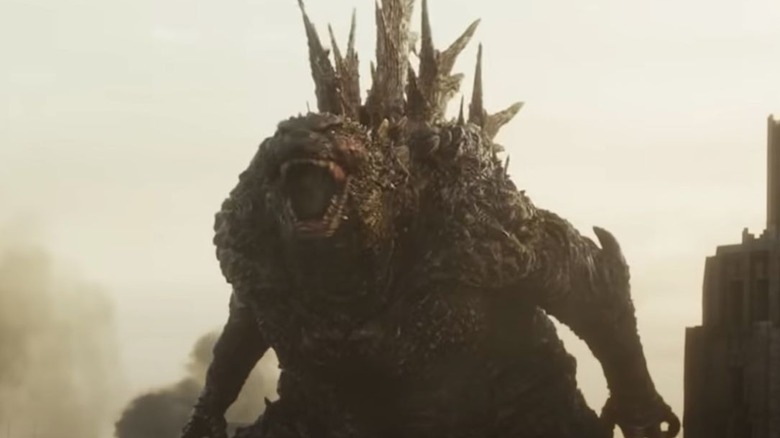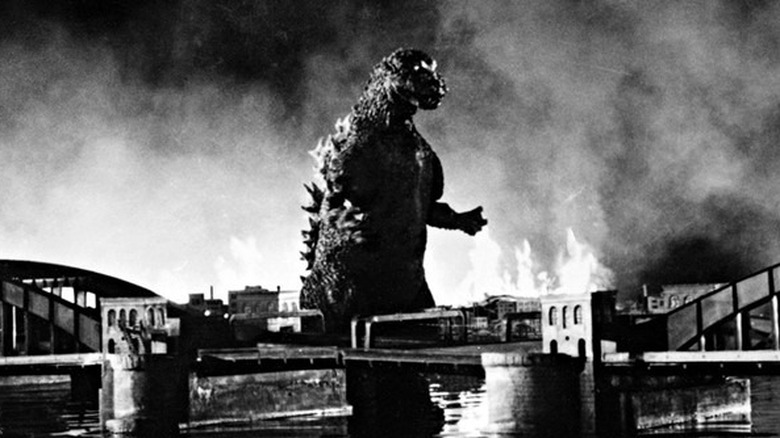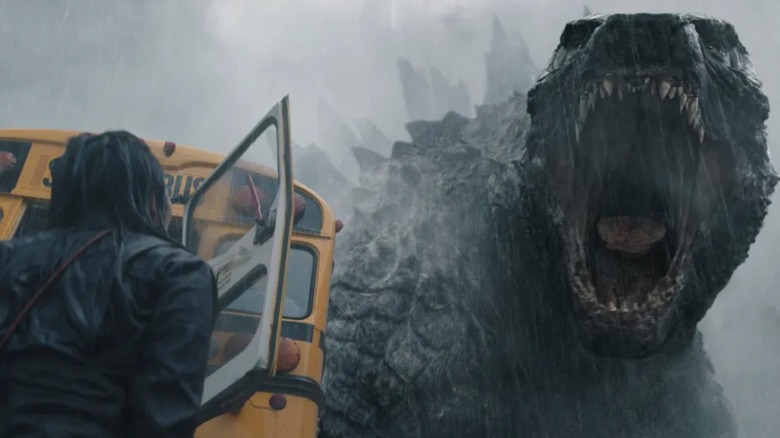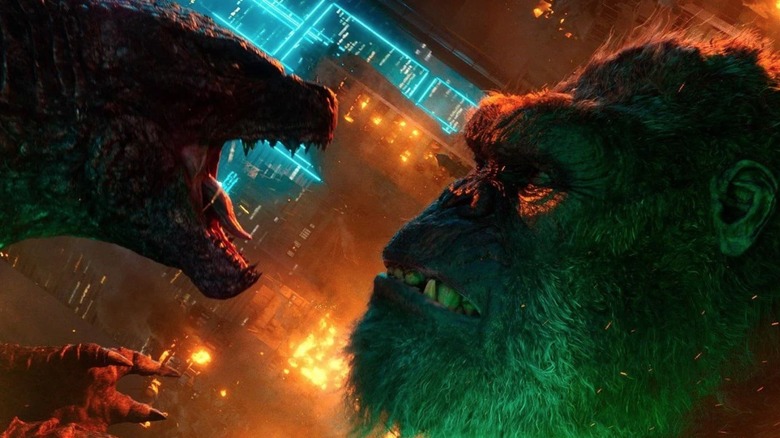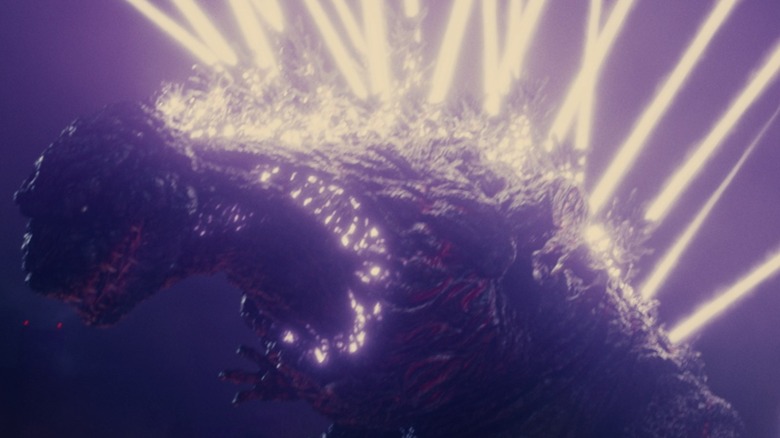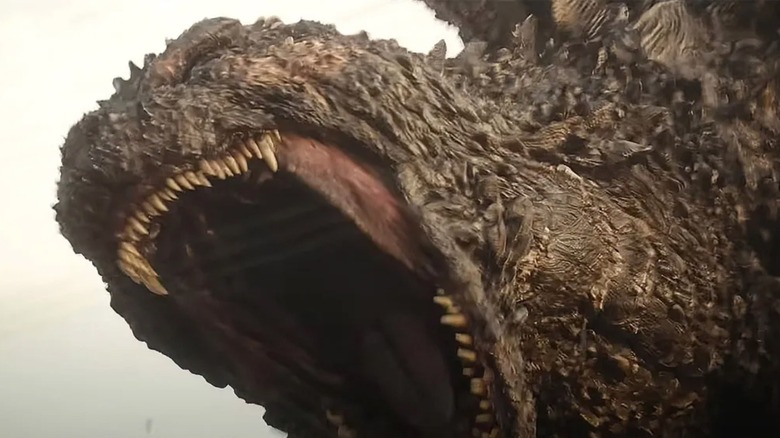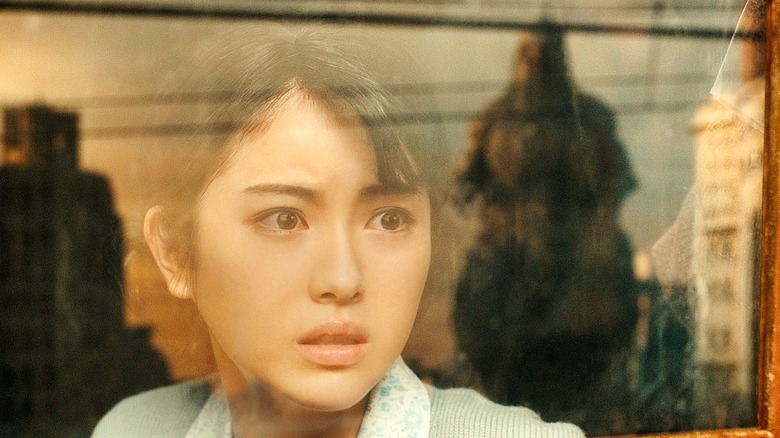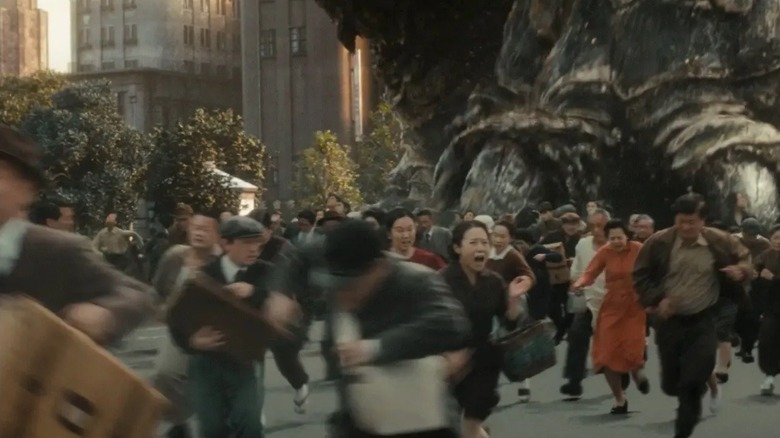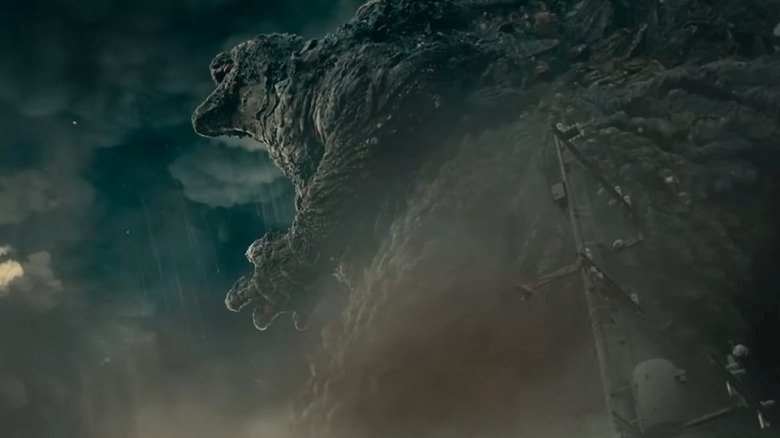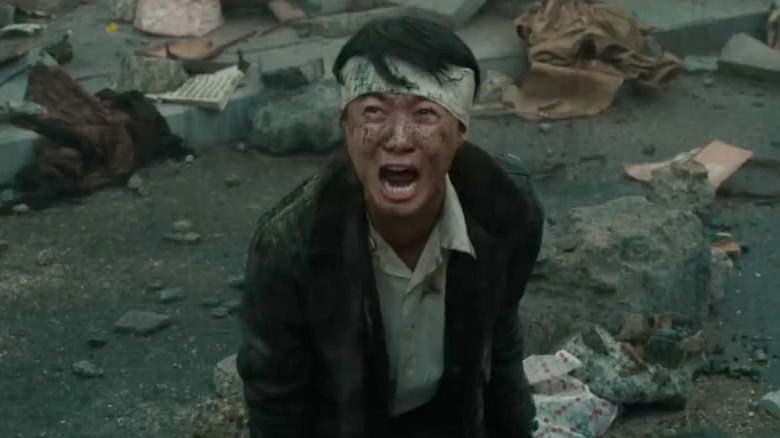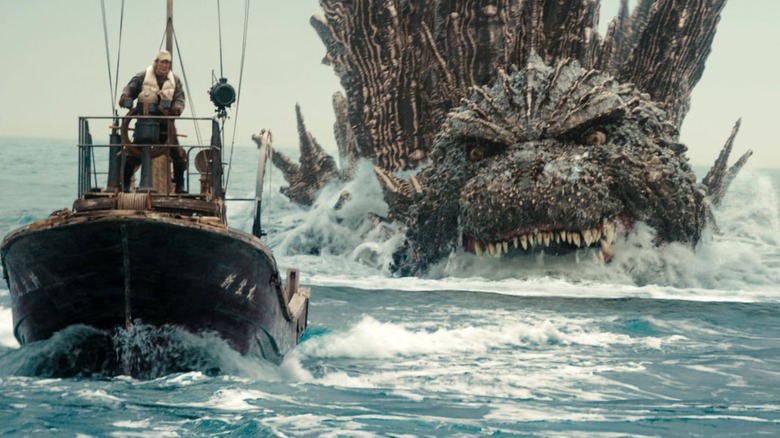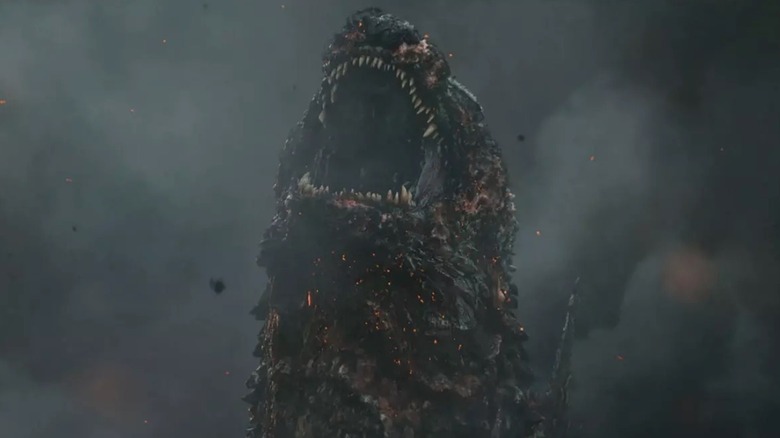Why Godzilla Minus One Blew Everyone Away At The Box Office
When they hit 70, most movie stars retire to Palm Springs. Not Godzilla. Since hitting septuagenarian status, the King of the Monsters is still wearing the box office crown as "Godzilla Minus One" — the franchise's 38th cinematic entry and 33rd Japanese film — became the sleeper hit of the season, grossing more than every non-Hollywood entry in the storied franchise. That's pretty impressive, considering Godzilla has been stomping screens since the middle of last century. But that wasn't all "Godzilla Minus One" accomplished.
Unadjusted for inflation, "Godzilla Minus One" is the highest-grossing Japanese language film ever in North America, and the fifth top-grossing foreign language film of all time domestically, topping "Parasite" and "Pan's Labyrinth." Not bad for a character most Western moviegoers associated with kitschy cheese-fests featuring men in rubber suits throwing hands ... until "Godzilla Minus One" changed the conversation. Even though "Godzilla Minus One" features one of the most famous characters ever, it's monster-sized success still caught Hollywood by surprise. Here's how it happened.
Light spoilers for "Godzilla Minus One" ahead.
What did Godzilla Minus One make at the box office?
"Godzilla Minus One" has blasted away $50 million at the domestic box office and just about $100 million worldwide — and counting. That may not seem like much, considering "Godzilla" (2014) earned $93 million in its first weekend alone, but context is important. At a budget of just $15 million, "Godzilla Minus One" cost less than one-10th the $160 million blockbuster budget of 2014's "Godzilla." So, while the 2014 summer smash earned more than three times its production budget with $529 million worldwide, "Godzilla Minus One" has earned almost six times what it cost to produce.
Put simply, the 2014 "Godzilla" was budgeted to be a summer blockbuster and delivered, while "Godzilla Minus One" had the price tag of an indie darling and way over-delivered. With its stateside gross accounting for more than 50 percent of its global total, "Godzilla Minus One" is also the first — and so far only — Japanese "Godzilla" flick to earn far more in North America than in the character's native land. Honestly, it's not even close. "Godzilla Minus One" has stomped the domestic totals earned by the last two Japanese Godzilla movies that were released stateside, earning 25 times more than "Shin Godzilla" ($1.9 million), and five times more than "Godzilla 2000" ($10 million). As it stands, "Godzilla Minus One" is the highest-grossing Japanese "Godzilla" movie of all time — both domestically and worldwide. What are the reasons for its colossal kaiju cashout?
Godzilla is an iconic character
It's not like Godzilla is some under-the-radar character that only indie film nerds know about. Godzilla is one of the most famous intellectual properties in pop culture history. He's so popular, his last name — "Zilla" — is an internationally recognized shorthand to convey size and destructive capability e.g. Bridezilla, Hogzilla, Truckzilla, we could go on. Slapping it on your product is also a great way to get a cease and desist from Toho.
While Godzilla's spiky mug has been found across just about every medium (yes, even McDonald's Happy Meals), his home base has always been the movies. Godzilla has starred in 33 Japanese films and five American ones, including "Godzilla Minus One" and the upcoming "Godzilla x Kong: The New Empire." With 38 films total, the "Godzilla" series boasts more movies than any other franchise, topping even the Marvel Cinematic Universe (33) and James Bond (25).
"Godzilla" is also the longest continuously running film franchise, with new entries being released during every decade since 1954. The biggest gap between movies was a mere 10 years between Japan's "Godzilla Final Wars" in 2004 and America's "Godzilla" in 2014. With a fanbase that stretches back 70 years, encompasses all ages and demos, and covers every corner of the globe, it wasn't surprising that "Godzilla Minus One" found an audience. It was the size of the audience that blew everyone away.
Godzilla is the (content) King of the Monsters
Content is king, and Godzilla is the king of the content monsters. With three major releases in just five months – Apple TV+'s "Monarch: Legacy of Monsters," "Godzilla Minus One," and the upcoming "Godzilla x Kong: The New Empire" — "Godzilla" is having a moment. Meanwhile, Netflix has released three "Godzilla" anime films and one series in the past seven years, as well as anime series starring Godzilla-adjacent characters Gamera, Ultraman, and Kong. "Godzilla" has also been prolific in comic books, including high-profile showdowns with The Mighty Morphin Power Rangers and Justice League. Honestly, only Taylor Swift and Travis Kelce are more omni-present, but Godzilla doesn't write love songs (yet).
But Godzilla's not the only one that's having his time in the rising sun, as Japanese pop culture in general is doing big business in the West. Hayao Miyazaki's "The Boy and The Heron" was recently the first Japanese language film to land at the top of the domestic box office, while Netflix's live-action anime adaption "One Piece" topped the Netflix charts. For long-time tokusatsu (i.e. Japanese sci-fi) junkies who grew up crossing their fingers that their favorite characters would maybe get a VHS release, this feels like the Upper World in "Dragon Ball Z." As one of the pillars of tokusatsu and the first Japanese character to achieve mainstream international stardom, it's only natural Godzilla should benefit from the Japanese pop culture renaissance.
The Monsterverse is a monster-sized global franchise
Godzilla was an A-lister for 60 years before Legendary Pictures unleashed the Monsterverse. Still, there's no denying that the multi-billion-dollar franchise has produced a nuclear explosion's-worth of renewed interest in the kaiju character and his colossal friends, as well as creating a new generation of fans. Across four films, the Monsterverse has earned a solid $580 million domestically, but a downright astounding $1.9 billion worldwide (monsters are big business in China). The upcoming "Godzilla x Kong: The New Empire" will only juice those numbers.
Interestingly enough, thanks to the $561 million earned by "Kong: Skull Island" (which only featured Godzilla in a cameo), the four-film franchise has actually earned pretty much the same as all 12 Godzilla movies released in the U.S. — $1.934 billion vs. $1.941 billion. While the increasingly outlandish Monsterverse is a far cry from the serious and somber "Godzilla Minus One," its success worldwide has been a rising tide that has lifted all "Godzilla" content.
Shin Godzilla set the stage
Don't take a drink every time a review says "Godzilla Minus One" is "the best 'Godzilla' movie in years" (you'll pass out). The statement is not only cliche, it's also misleading. With glowing reviews and blockbuster grosses, another successful Japanese "Godzilla" movie came out less than a decade ago – "Shin Godzilla."
While only $1.9 million of its $75 million worldwide came from North America, "Shin Godzilla" made more than twice as much in his native Japan as "Godzilla Minus One" – $75 million versus $35.6 million. By the end of its run, "Shin Godzilla" became the second highest-grossing film at the Japanese box office for the year, and is still the most successful "Godzilla" film in Japan ever, unadjusted for inflation. "Shin Godzilla" was also the big winner at the Japanese Academy Awards, receiving 11 nominations and winning seven, including best picture and best director, for Hideaki Anno and Shinji Higuchi.
Why was "Shin Godzilla" so much more successful in Japan — while "Godzilla Minus One" has dominated North America? "Shin Godzilla" is a quirky satire of Japanese government bureaucracy that resonated with Japanese moviegoers, while "Godzilla Minus One" feels like a classic Spielbergian summer blockbuster that plays well to American audiences. Even though "Shin Godzilla" only got a limited American release, its strong per-theater average and record-breaking Japanese run set the stage for "Godzilla Minus One." Put another way, "Shin Godzilla" walked so "Godzilla Minus One" could stomp.
Godzilla Minus One gets plus one for timing
Timing is everything in show business and the timing was perfect for "Godzilla Minus One" to thrive at the box office. Thanks to the dual strikes between the WGA and SAG-AFTRA, many major fall 2023 releases were postponed, including "Dune Part II," "Kraven the Hunter," and "Ghostbusters: Frozen Empire." While we can debate how successful those movies would have been, they definitely would have taken screen space from "Godzilla Minus One."
Even among the films that did get released in the summer and fall, moviegoers were starved for crowd-pleasing action flicks. "Shazam! Fury of the Gods," "The Flash," "Indiana Jones and The Dial of Destiny," "Blue Beetle," and a stream of other action movies underperformed or flat out tanked in 2023. This string of box office bad luck culminated in what was once thought unthinkable when "The Marvels," (released just a few weeks before "Godzilla Minus One"), became the first box office bomb in the MCU, with $200 million worldwide on a $275 million budget.
Superhero and franchise fatigue (heck, make that flat out exhaustion) was in full force in 2023. So how did the 38th film in a 70-year-old franchise avoid a similar fate? By giving audiences what they wanted — a fresh yet familiar take on a classic character. Turns out moviegoers wanted to be told a great story, not to be sold more "content."
Godzilla Minus One got glowing critical reviews
When it comes to popcorn movies, critical reviews can be almost irrelevant. Critic-proof movies can survive scathing reviews if moviegoer demand is strong enough, while even would-be blockbusters that critics love don't stand a chance if the audience just doesn't care.
It's a different story with art house or prestige films, which need the attention and credibility that positive reviews can generate. It's one thing if you're going to a movie just to watch stuff blow up on the biggest screen available; but if you're going to the trouble of buying a ticket and going to the theater hoping to see a good movie you expect it to be, y'know, good, right? Otherwise, you'd just wait for streaming. In this case, critical reviews are a solid filter for determining whether a movie is worth your time and money.
Okay, you may be rolling your eyes at the implication that a "Godzilla" flick is "art house" or "prestige." But remember, "Godzilla Minus One" was still a foreign-language film that was originally given a one-week release — that's not exactly a recipe for mainstream multiplex success. Besides, it's also a genre many North American moviegoers associate with low-budget schlock. "New Godzilla movie" doesn't exactly scream "high art," but "Godzilla Minus One" is different. The films' near-perfect reviews helped drive initial interest from more discerning cinema fans who might not otherwise go to a "Godzilla" movie.
Moviegoers gave it wonderful word-of-mouth
Word-of-mouth marketing is the best advertising there is. While the water cooler may not exist in the literal sense, people still like discovering and sharing great films with each other. After all, we can only talk about football so much. Based on the exceptional audience response, "Godzilla Minus One" resonated with moviegoers in a massive way.
You can tell that moviegoers dug "Godzilla Minus One" based on how it has performed week-to-week. "Godzilla" movies tend to be front-loaded, indicating a surge of initial fan interest, but not much staying power with general audiences. "Godzilla" (2014) earned 46% of its domestic gross in its opening weekend, while its sequel, "Godzilla: King of the Monsters," (2019) earned 43% of its cash in its first three days. Even the more well-received "Godzilla vs. Kong" earned 32% of its money in its opening weekend. Meanwhile, "Godzilla Minus One" earned $11.5 million during its December 1-3 opening, which so far is only 22% of its $50 million (and counting) domestic box office.
Based on its stronger-than-expected opening weekend, Toho International not only continued the film's initial limited, one-week run, but expanded the theater count from 2,308 to 2,622. It was a good move, too, as "Godzilla Minus One” only dropped 25% to $8.5 million in its sophomore frame, one of the best holds of 2023. Results like these indicate only one thing — some moviegoers were seeing "Godzilla Minus One" more than once and recommending it to others.
Godzilla Minus One tells a timeless tale
"They just don't make movies like this anymore" may be a cliche, but it's also a perfect description of "Godzilla Minus One." Because the truth is, they really don't. Thanks to the Marvel-ization of blockbuster filmmaking, many Hollywood franchises bear its hallmarks: snarky humor, bloated and bland CG battle scenes, and a self-aware postmodernist philosophy that constantly winks at the audience to remind us that we're watching a movie. It was fun while it lasted, with the box office billions to boot, but moviegoers are clearly craving an old-school style of storytelling that, well, they just don't make anymore.
With a plot that can be broken down into a single sentence — "a pilot must overcome his trauma to help defeat an existential threat" – "Godzilla Minus One" follows a traditional storytelling structure that puts it in conversation with canonized fantasy tales like "Star Wars" and "The Lord of the Rings." Its relatively simple premise replaces snarkiness and snideness with the earnestness and honesty that has defined storytellers for centuries, from Sophocles to Shakespeare to Spielberg — and yes, "Godzilla" movies, too.
"Avatar: The Way of Water" and "Top Gun: Maverick" proved the power of this approach in 2022, topping the worldwide box office with $2.3 billion and $1.5 billion respectively. "Godzilla Minus One" continued the trend in 2023, and may light the way for future Hollywood films.
Moviegoers connected with the human characters
"Nobody watches 'Godzilla' movies for the human characters" is a phrase deployed so often it's practically a prerequisite. Well, apparently "Godzilla Minus One" writer and director Takashi Yamazaki didn't get the memo, as the human characters in his film are arguably the best part ... or at least a close second.
Action movies work best when you care about the characters, yet in most "Godzilla" movies, Japanese or American, the humans are usually just there for exposition or to fill in the blanks between monster scenes, but this is not so in "Godzilla Minus One." In a refreshing twist, the non-kaiju characters are a feature, not a bug in "Godzilla Minus One" thanks to Yamazaki's brilliant writing and compelling performances from its ensemble cast.
Set in post-war Japan, "Godzilla Minus One" tells the story of Koichi Shikishima, a would-be kamikaze pilot suffering from PTSD and survivor's guilt who returns to Tokyo to find his parents killed and his home destroyed by American fire bombings. While he achieves some solace after taking in a homeless woman and her adopted daughter, he's unable to truly rebuild because "his war is not over." That alone would be a terrific story, and Godzilla is the 200-foot tall, radioactive gravy.
Shikishima overcoming his own personal obstacles to confront the existential threat that is Godzilla is Hero's Journey 101 stuff. The result is a profound, powerful, and yes, human story that manages to achieve the impossible: make you root against Godzilla. Well, almost.
The action scenes are awe-inspiring
Godzilla has thrown down with King Kong, King Ghidorah, Mothra, and Rodan, among others, yet the King of the Monsters flies solo in "Godzilla Minus One." As much as we love seeing the Titans tangle, we don't miss the other residents of Monster Island (though we'd love to see them in a sequel). Some would argue that "Godzilla Minus One" boasts the most exciting SFX of the entire "Godzilla" series, (yes, even the much bigger budgeted Monsterverse movies), and frankly some of the most impressive action scenes of any blockbuster, period, in years.
Godzilla's de facto mano y mano with the military feels fresh, Godzilla's nuclear breath will leave you breathless, and the scene of Godzilla stalking the minesweeper (in a clear homage to "Jaws") is one of the most memorable moments from any "Godzilla" movie — or from any movie last year. While we've seen Godzilla stomp cities into submission countless times, "Godzilla Minus One" manages to make these familiar scenes feel like the first time, with a ground-level POV that conveys the true horror of seeing a skyscraper-sized reptile burn your home to the ground.
Credit writer, director and SFX director Takashi Yamazaki, pulling triple duty, who makes the movie's approximately $15 million budget (close to what catering costs on a Hollywood production) look like $150 million. Yet, ironically, Yamazaki's limited resources may have been to the movie's benefit. He couldn't just throw cash at any problem; he had to use creativity. Pardon the pun, but the results are simply smashing.
Godzilla Minus One resonated with moviegoers across the board
Sure, a movie can make money by only appealing to its core fanbase, which is probably all Toho International expected when it released "Godzilla Minus One" to theaters in North America. But to achieve blockbuster status, a movie must broaden its audience. This is true for everything from "The Dark Knight" to "The Avengers" to "Barbie." If each of those movies only reached their core demo, they would have turned a tidy profit, but wouldn't have earned a pile of cash so high Scrooge McDuck could dive into it. The same is true for "Godzilla Minus One."
"Godzilla Minus One" has succeeded because it is the complete package. While "Godzilla" fans were always going to show up, the $1.9 domestic gross for "Shin Godzilla" in 2016 showed that a Japanese language "Godzilla" film had a relatively niche audience. "Godzilla Minus One" became a must-see with art house cineastes thanks to its glowing reviews, while its incredible word-of-mouth convinced casual moviegoers to head to the big screen.
Whether you're a lifelong "Godzilla" lover or normally roll your eyes at kaiju cinema; you're a foreign language film fanatic or someone who prefers a solid popcorn flick, "Godzilla Minus One" delivered something for everyone. More than any other factor, it was the movie's across-the-board crowd-pleasing appeal that made "Godzilla Minus One" blow everyone away at the box office.
